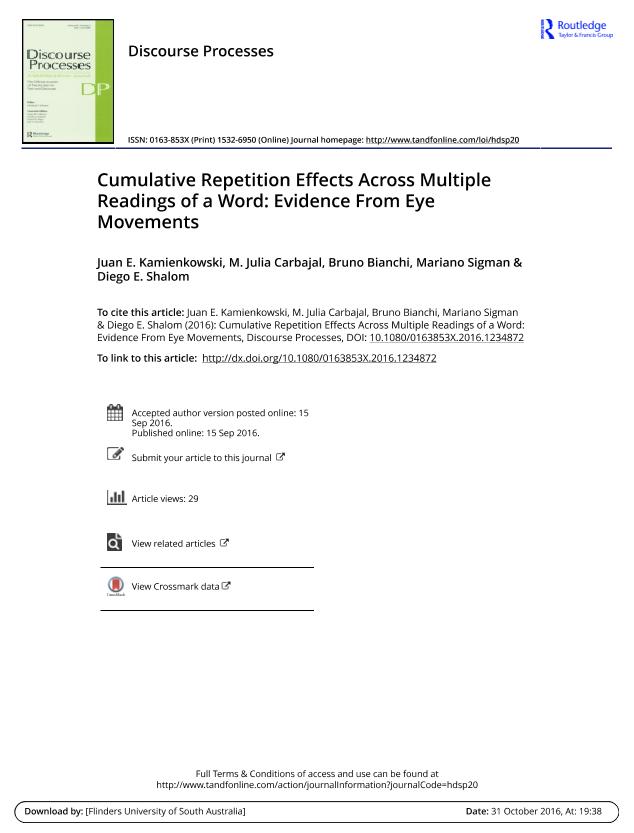Artículo
Cumulative Repetition Effects Across Multiple Readings of a Word: Evidence From Eye Movements
Kamienkowski, Juan Esteban ; Carbajal, María Julia; Bianchi, Bruno; Sigman, Mariano
; Carbajal, María Julia; Bianchi, Bruno; Sigman, Mariano ; Shalóm, Diego Edgar
; Shalóm, Diego Edgar
 ; Carbajal, María Julia; Bianchi, Bruno; Sigman, Mariano
; Carbajal, María Julia; Bianchi, Bruno; Sigman, Mariano ; Shalóm, Diego Edgar
; Shalóm, Diego Edgar
Fecha de publicación:
04/2018
Editorial:
Taylor & Francis
Revista:
Discourse Processes
ISSN:
0163-853X
e-ISSN:
1532-6950
Idioma:
Inglés
Tipo de recurso:
Artículo publicado
Clasificación temática:
Resumen
When a word is read more than once, reading time generally decreases in the successive occurrences. This Repetition Effect has been used to study word encoding and memory processes in a variety of experimental measures. We studied naturally occurring repetitions of words within normal texts (stories of around 3,000 words). Using linear mixed models to analyze the evolution of fixations over successive repetitions, we observed an interaction between corpus word frequency and repetition. Specifically, we found a decrease in fixation durations in words with low frequency but not with high frequency, and both values converged after five or six repetitions. Furthermore, we showed that repetition of a lemma is not enough to evoke this effect. Our results are in agreement with predictions formulated by the context-dependent representation model, and this adds new arguments to the discussion of the sources of the repetition effect.
Palabras clave:
Reading Time
,
Repetition Effect
Archivos asociados
Licencia
Identificadores
Colecciones
Articulos(ICC)
Articulos de INSTITUTO DE INVESTIGACION EN CIENCIAS DE LA COMPUTACION
Articulos de INSTITUTO DE INVESTIGACION EN CIENCIAS DE LA COMPUTACION
Articulos(OCA CIUDAD UNIVERSITARIA)
Articulos de OFICINA DE COORDINACION ADMINISTRATIVA CIUDAD UNIVERSITARIA
Articulos de OFICINA DE COORDINACION ADMINISTRATIVA CIUDAD UNIVERSITARIA
Articulos(SEDE CENTRAL)
Articulos de SEDE CENTRAL
Articulos de SEDE CENTRAL
Citación
Kamienkowski, Juan Esteban; Carbajal, María Julia; Bianchi, Bruno; Sigman, Mariano; Shalóm, Diego Edgar; Cumulative Repetition Effects Across Multiple Readings of a Word: Evidence From Eye Movements; Taylor & Francis; Discourse Processes; 55; 3; 4-2018; 256-271
Compartir
Altmétricas



